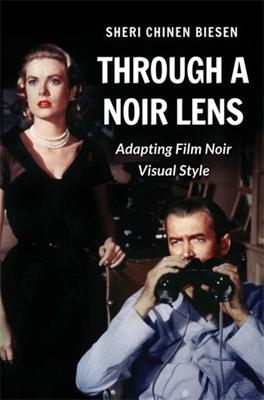Shadows. Smoke. Dark alleys. Rain-slicked city streets. These are iconic elements of film noir visual style. Long after its 1940s heyday, noir hallmarks continue to appear in a variety of new media forms and styles. What has made the noir aesthetic at once enduring and adaptable?
Sheri Chinen Biesen explores how the dark cinematic noir style has evolved across eras, from classic Hollywood to present-day streaming services. Examining both aesthetics and material production conditions, she demonstrates how technological and industrial changes have influenced the imagery of film noir. When it emerged in the early 1940s, the visual style's distinctive shadowy look was in part a product of wartime cinema conditions and technologies, such as blackouts and nitrate film stock. Since the 1950s, technical developments from acetate film stock and new cameras and lenses to lighting, color, and digitization have shaped the changing nature of noir style. Biesen considers the persistence of the noir legacy, discussing how neo-noirs reimagine iconic imagery and why noir style has become a touchstone in the streaming era. Drawing on a wealth of archival research, she provides insightful analyses of a wide range of works, from masterpieces directed by Billy Wilder and Alfred Hitchcock to New Hollywood neo-noirs, the Coen brothers' revisionist films, and recent HBO and Netflix series. A groundbreaking technological and industrial history of an essential yet slippery visual style, Through a Noir Lens shines a light into the shadows of film noir.
Book
Through a Noir Lens: Adapting Film Noir Visual Style
(Write a Review)
$100.00
Shadows. Smoke. Dark alleys. Rain-slicked city streets. These are iconic elements of film noir visual style. Long after its 1940s heyday, noir hallmarks continue to appear in a variety of new media forms and styles. What has made the noir aesthetic at once enduring and adaptable?
Sheri Chinen Biesen explores how the dark cinematic noir style has evolved across eras, from classic Hollywood to present-day streaming services. Examining both aesthetics and material production conditions, she demonstrates how technological and industrial changes have influenced the imagery of film noir. When it emerged in the early 1940s, the visual style's distinctive shadowy look was in part a product of wartime cinema conditions and technologies, such as blackouts and nitrate film stock. Since the 1950s, technical developments from acetate film stock and new cameras and lenses to lighting, color, and digitization have shaped the changing nature of noir style. Biesen considers the persistence of the noir legacy, discussing how neo-noirs reimagine iconic imagery and why noir style has become a touchstone in the streaming era. Drawing on a wealth of archival research, she provides insightful analyses of a wide range of works, from masterpieces directed by Billy Wilder and Alfred Hitchcock to New Hollywood neo-noirs, the Coen brothers' revisionist films, and recent HBO and Netflix series. A groundbreaking technological and industrial history of an essential yet slippery visual style, Through a Noir Lens shines a light into the shadows of film noir.Hardcover
$100.00